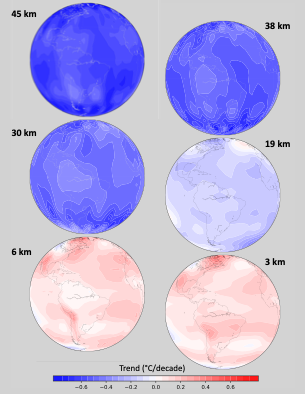Human Fingerprints in the Sky
Scientists at Lawrence Livermore National Laboratory, in collaboration with colleagues from nine other institutions, assessed the pattern similarity between modeled and observed atmospheric temperature changes. The observed changes are consistent with model simulations that include human emissions of greenhouse gases and cannot be reproduced by simulations that exclude human influence.
The researchers found that including mid and upper-stratospheric temperature information enhances the detectability of human influence on the thermal structure of the atmosphere by a factor of five. These results indicate that purely natural explanations for the pattern of atmospheric temperature change are virtually impossible.
Over a half-century ago, pioneering climate modeling studies demonstrated that an increase in atmospheric CO2 concentration warms the troposphere and cools the lower stratosphere. This result still holds today in more sophisticated climate models. In the past decade, this basic pattern was detected in satellite-based microwave observations of atmospheric temperature change, enabling researchers to detect “human influence” in the latitude-altitude pattern of atmospheric temperature change. Previous studies had been limited to analyses covering the lower troposphere to the lower stratosphere. Improvements to climate models and satellite observations now allow scientists to extend comparisons of observations and model simulations to the upper stratosphere. The inclusion of mid- and upper-stratospheric temperature data enhances the detectability of human influence by a factor of five. This improvement is driven by the large greenhouse gas-induced cooling response of the upper stratosphere, the small upper stratospheric “noise” due to natural climate variations, and the distinct differences between the “human influence” and noise patterns in this atmospheric region. The results mean that human activities have altered the thermal structure of Earth’s atmosphere, and natural explanations for these changes are untenable.

